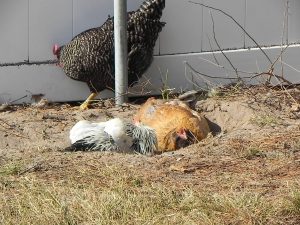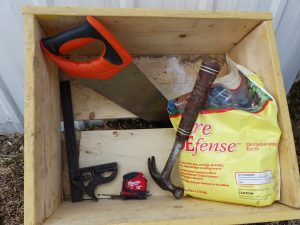People mowing their lawn, tilling the garden, or doing almost any home or yard chore usually finish tired, hungry, and dirty. Nothing’s quite as luxurious after a hard day’s work as a warm bath or sudsy shower to remove grime and relax taxed muscles.
Chickens aren’t as lucky. Like humans they work hard scratching the dirt for delicious bugs and seeds and giving their human owner a nearly daily nest gem……an egg. Unfortunately, they can’t end the day’s labor with a bath or shower the way people can. Yet, chickens are fastidious about body care and appreciate the opportunity to clean themselves.
Many wild birds enjoy a watery bath in a shallow pond or birdbath. They fluff their feathers and shake water into them. Chickens usually don’t have a pond nearby so they use a different cleaning strategy.

When you watch a chicken hunker down in dusty ground it’s easy to see their delight in rubbing belly feathers in the dirt and fluffing dust into their wings and backs. If humans rolled around in the dirt, we’d emerge filthy. Hens exit their dust bath looking like they just left a spa. They’re clean, tidy, and look pleased with their grooming. Fine dust also helps rid them of parasites lurking under feathers.
How chickens use dirt to clean themselves is a mystery. What’s certain is that providing a place to dust helps them be clean, healthy and look sharp.
Hens lucky enough to have a spacious run often dig down into dry soil to create their own dust bed. It works well during dry spells, but when rain transforms dust to mud chickens skip bathing until it dries out. Hens will dust indoors if the coop’s litter includes at least five or six inches of dry wood chips or sawdust. They’ll hunker into the litter and scratch wood chips about as they fluff it into their feathers.
Fortunate chickens have owners who’ve installed a dust bath. They are easy to build and function perfectly if the outside run is hard packed or muddy, and thin indoor litter discourages dusting.
A shallow plastic, wood, or metal box or bowl can be transformed into a dust bath.
It should be about two feet in diameter with sides from eight inches to a foot high. Exact dimensions aren’t important. Fill it two thirds deep with fine powdery dry dirt. Sand and diatomaceous earth can be mixed in.

Diatomaceous earth can be purchased at farm and garden stores and is the finely ground skeletons of long dead diatoms, tiny creatures that live in water. The powder is microscopic pointy spikes of calcium. Any parasite lurking under a hen’s feathers will get stabbed by the diatomaceous spikes and die of dehydration. It helps reduce pests without using poisons.
Exact size, shape and depth are not critical. Here’s all what’s needed to make a two foot by two foot dust bath:
- One eight-foot long 1×10 or 1X12 board
- A handful of nails
- A saw to cut the board into four two (2) foot sections. A square and pencil helps make straight cuts
- Hammer
To assemble, merely hammer the four short boards into a square. Installing a bottom, or floor, is optional and usually not needed. Place the bath in the run or coop and fill with dry fine dirt or sawdust and add a cup or two of diatomaceous earth (It’s optional).
The chickens will do the rest. Their fluffing will spill some dirt out, so it needs to be refilled from time to time.
A simple dust bath is an inexpensive and fun way to help keep chickens clean and happy.